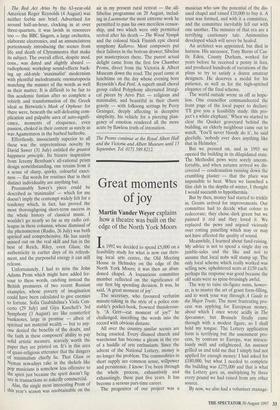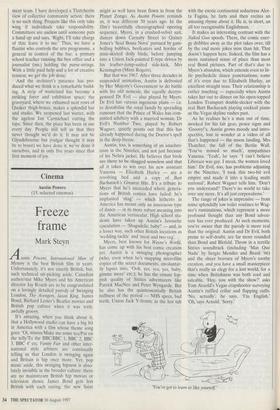Great moments of joy
Martin Vander Weyer explains how a theatre was built on the edge of the North York Moors In 1992 we decided to spend £5,000 on a feasibility study for what is now our thriv- ing local arts centre, the Old Meeting House in Helmsley on the edge of the North York Moors; it was then an aban- doned chapel. A loquacious committee member reflected on the significance of our first big spending decision. It was, he said, 'A great moment of joy'. The secretary, who favoured verbatim minute-taking in the style of a police con- stable's pocket-book, frowned thunderous- ly. 'A Grrr—eat moment of joy?' he challenged, inscribing the words into the record with obvious distaste.
All over the country similar scenes are being enacted. Every disused church and warehouse has become a gleam in the eye of a huddle of arts enthusiasts. Since the advent of the National Lottery, money is no longer the problem. The commodities in short supply are common sense, willpower and persistence. I know: I've been through the whole process, exhaustively and exhaustingly, these past five years. It has become a serious part-time career.
The progenitor of our project was a musician who saw the potential of the dis- used chapel and raised £10,000 to buy it. A trust was formed, and with it a committee, and the committee inevitably fell out with one another. The minutes of that era are a terrifying cautionary tale. Animosities developed which will never be healed.
An architect was appointed, but died in harness. His successor, Tony Bums of Cas- tle Eden, County Durham, worked for years before he received a penny in fees, and produced hundreds of variations of the plans to try to satisfy a dozen amateur designers. He deserves a medal for his patience, as well as for the high-spirited elegance of the final scheme.
The world outside wrote us off as hope- less. One councillor commandeered the front page of the local paper to declare: `I'll give you a feasibility study: this pro- ject's a white elephant.' When we started to clear the Quaker graveyard behind the building, an elderly neighbour came out to watch. 'You'll never bloody do it', he said gleefully, 'nobody ever does anything like that in Helmsley.'
But we pressed on, and in 1993 we opened the building in its dilapidated state. The Methodist pews were sorely uncom- fortable, and when autumn arrived we dis- covered — condensation running down the crumbling plaster — that the place was impossible to heat. When we launched a film club in the depths of winter, I thought I would succumb to hypothermia.
But by then, money had started to trickle in. Grants arrived for improvements. Our committee had to decide what colour to redecorate; they chose dark green but we painted it red and they loved it. We replaced the pews and argued viciously over rotting panelling which may or may not have affected the quality of sound.
Meanwhile, I learned about fund-raising. My advice is not to spend a single day on jumble-sales and the like and not to assume that local nobs will stump up. The only local scheme which really worked was selling new, upholstered seats at £150 each; perhaps the response was good because the old seats were so spine-bruisingly awful.
The way to raise six-figure sums, howev- er, is to master the art of grant form-filling, and to work your way through A Guide to the Major Trusts. The most frustrating pro- cess was applying for European money, about which I once wrote acidly in The Specatator, but Brussels finally came through with a modest figure, so I shall hold my tongue. The Lottery application form is terrifying but the assessment pro- cess, by contrast to Europe, was miracu- lously swift and enlightened. An assessor grilled us and told me that I simply had not applied for enough money: I had asked for £180,000, but what I needed to complete the building was £275,000 and that is what the Lottery gave us, multiplying by three every pound we had raised from any other source.
By now, we also had a volunteer manage- ment team. I have developed a Thatcherite view of collective community action: there is no such thing. Projects like this only take wing if individuals take responsibility. Committees are useless until someone puts a hand up and says, 'Right, I'll take charge of this; leave it to me.' Thus, we have a flautist who controls the arts programme, a general in control of the bar, a primary school teacher running the box office and a journalist (me) holding the purse-strings. With a little paid help and a lot of creative tension, we get the job done.
And the architect's patience has pro- duced what we think is a remarkable build- ing. A strip of wasteland has become a striking foyer and exhibition space; the graveyard, where we exhumed neat rows of Quaker thigh-bones, makes a splendid bar and studio. We reopened last winter, with the ageless Ian Carmichael cutting the tape. Since then, the place has been in use every day. People still tell us that they never thought we'd do it. It may not be Glyndebourne but (vulgar thought it may be to boast) we have done it, we've done it ourselves, and in only five years since that first moment of joy.



















































 Previous page
Previous page